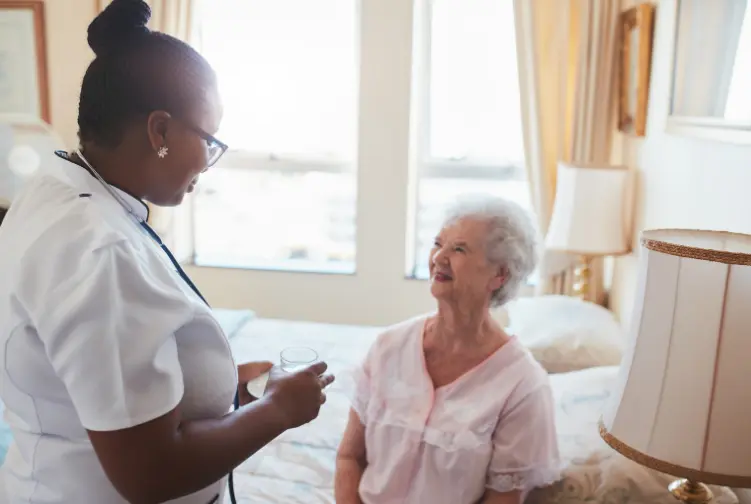Making care environments more homely
Posted on 13 July 2017 By Aaron Stretton

In This Article
In the healthcare sector, there is constant battle to make equipment both highly-functional and aesthetically pleasing. This equipment is needed…
In the healthcare sector, there is constant battle to make equipment both highly-functional and aesthetically pleasing. This equipment is needed especially in care environments like hospices, care homes, and dementia units to name just a few. These places need to remain homely in decor to allow the residents/patients to feel truly comfortable. Whilst this may seem difficult (especially if you conjure up images of old hoisting systems that hung like cranes above patients’ heads), it can be achieved through a few simple steps.
Homeliness
Achieving a homely feeling care environment is incredibly important. For example, if you have a family looking at prospective care homes for their loved ones, they will be more inclined to choose one that doesn’t look overly clinical and cold. Even charities like Age UK tell families to look for homeliness when looking at care environments.
A homely aesthetic can immediately make the individual feel more comfortable and less intimidated. It also gives a sense of community amongst residents/patients, which is integral to improving quality of care, and quality of life.
Decor, Colours, and Lighting
Of course, the decor of a care environment is instrumental in making sure that it feels less clinical. For places that accommodate older residents (e.g.- dementia units and care homes), recent studies have shown that having a nostalgic decor can be particularly soothing because it is an aesthetic that the residents are familiar with. By taking small steps like this, care environments can make people feel more at ease.
Colours have proven to be particularly interesting in dementia-friendly environments. Certain colours can help to relax residents, and high contrast colours can help to draw their eye to important object. For example, things like grab rails can be spotted more easily if they’re red. This makes it easier for individuals to stay active, mobile, and independent without relying too heavily on caregivers.
Similarly, lighting has shown to influence the individual’s mental state and ability to remain mobile. Where it is possible, natural lighting should be used to make the environment feel homelier. If this is not possible, then there are things like high luminance lighting that can help to replicate the effects of natural lighting. Interestingly, high luminance lighting has also been shown to improve your mood. If residents/patients are struggling to maintain a healthy sleep pattern, intelligent lighting systems can help to adjust their biological rhythm. This will help to make residents feel more comfortable in the environment.
Furniture
Making sure that your facility has the most discreet furniture is also a bonus when creating a homely environment. Some areas of healthcare equipment are a bit more difficult to make less clinical — particularly siderails. What with bed rails having their own set of regulations in England, it can be difficult to find a bed that will safeguard the user without appearing obtrusive. The Liberta bed ticks all the boxes for any care home, boasting adjustable mesh side panels that are in line with the regulations without making the resident feel imprisoned or confined. The profiling abilities of this bed also make it ideal for repositioning individuals with ease. With the ability to customise the bed in a variety of wood colours and finishes, the Liberta can be made to fit in with an existing decor.
We can also provide bespoke fitted and loose furniture that can match the Liberta and really tie the room together for a truly cosy feeling. The Edge furniture range has proven to be particularly popular with care homes and hospices over the years, and we even have our own Dementia furniture range that helps the individual to see clearly where their items are with no confusion.
Hoisting Equipment
To reflect the need for more subtle healthcare equipment, hoisting systems have also become less clinical looking. In particular, the Integralift hidden hoist system is ideal for any care environment that doesn’t want to sacrifice a homely feel. This hoist folds into a cupboard unit at the head of the resident’s bed, giving reliable, sturdy transfers to and from the bed with ease. It also provides extra storage space for medical gases and such, maintaining the overall homely feel in the room. With these clinical things being hidden away, residents are sure to be more comfortable in a care facility.
However, if a more complex hoisting system is needed, then inset tracking is the way to go. This is hoist tracking that is inset into the ceiling itself, meaning that it does not hang low and detract from homely aesthetics. Inset tracking can provide a more comprehensive hoisting system in the room, without detracting from the comfortable feeling. This can be used with monorail tracks and X-Y systems, making it particularly flexible as an aesthetically pleasing solution that does not let down on safe, smooth transfers.
Conclusion
These simple steps can make all the difference in a care environment. From making sure your equipment isn’t clinical looking, right through to retro decor and natural lighting, our interior design service ensures that your facility provides the best surroundings for any residents and patients.
There are many ways that can help you to ensure that residents and patients have the best quality of life possible. Don’t forget that if you’re stuck for other ways to make your care environment equipment homelier, we can help to specify the best items that will blend in with ease.
Every sector has different requirements when it comes to equipment and decor. Click here to find out which different sectors we can work with.
Speak to The Experts
Need assistance with product enquiries, general inquiries, or product support? Our Phonelines are open 9am - 5pm Monday to Friday
0113 519 0319
Or, fill out the form for a call back.
